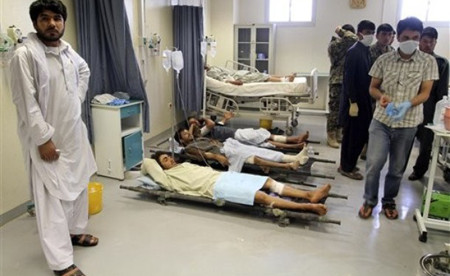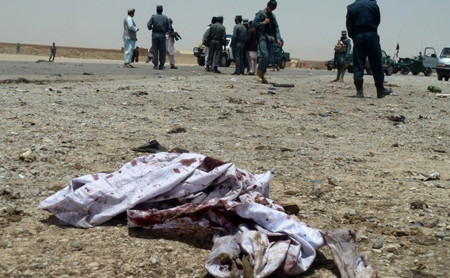Three suicide attackers blew themselves up in the largest city in southern Afghanistan Wednesday, killing 22 people and wounding at least 50 others in a dusty marketplace that was turned into a gruesome scene of blood and bodies.
In the east, Afghan officials and residents said a pre-dawn NATO airstrike targeting militants killed civilians celebrating a wedding, including women and children, although a NATO forces spokesman said they had no reports of civilians being killed in the overnight raid to capture a local Taliban leader.
Also in the east, NATO said two service members were killed in a helicopter crash. The coalition did not disclose any other information about the crash, but a senior U.S. defense official at the Pentagon said two American pilots were killed in the crash in Ghazni province. The official, who spoke on condition of anonymity because he was not authorized to disclose details of the crash, said there was no indication of enemy activity in the area at the time. Taliban spokesman Zabiullah Mujahid claimed in an e-mail that the insurgents shot down the helicopter.
Taliban spokesman Qari Yousef Ahmadi claimed responsibility for the attack in Kandahar, the capital of Kandahar province and the spiritual birthplace of the insurgency.
In the past two years, tens of thousands of U.S.-led coalition troops have flooded Taliban strongholds in the south, and have largely succeeded in boosting security there. But the Taliban have proven resilient, continuing to conduct suicide attacks and targeted assassinations of pro-government figures, opening up new fronts in the north and west and stepping up attacks in the east.
Afghan President Hamid Karzai condemned the attack on innocent civilians, saying it proved the "enemy is getting weaker because they are killing innocent people."
The explosion occurred about five kilometers (three miles) from the main gate of the massive military installation run by the U.S.-led coalition and roughly 500 meters (yards) from an Afghan military base.

Afghan victims of a suicide attack are seen on stretchers at a hospital in Kandahar, south of Kabul, Afghanistan, Wednesday, June 6, 2012. Two suicide bombers blew themselves up in a market area in southern Afghanistan on Wednesday, killing and wounding scores of people, authorities said. (Photo: AP)

Afghan policemen stand at the site of a twin suicide attack in a parking lot holding dozens of trucks supplying the NATO-run Kandahar Air Base on June 6, 2012. A twin suicide bombing attack killed 23 people on June 6 in a car park crammed with vehicles supplying a major NATO base in Afghanistan's southern province of Kandahar, police said. A suicide bomber on a motorcycle struck first and as a crowd gathered to help the victims a second bomber walked into their midst and set off explosives strapped to his body, provincial police chief General Abdul Raziq told. (Photo: AP)
One suicide bomber detonated a three-wheeled motorbike filled with explosives first, said Rahmatullah Atrafi, deputy police chief in Kandahar province. Then, as people rushed to assist the casualties, two other suicide bombers on foot walked up to the site and blew themselves up, he said.
Eight private security guards were among the 22 killed along a main road on the east side of the city, he said.
Small shops and private security company offices line one side of the road. Large trucks that supply logistics to Kandahar Air Field regularly park along the other side.
The explosions left a bloody scene of body parts, shoes, soda cans, snacks and debris from three shops that were destroyed.
Mohammad Naeem, a 30-year-old shopkeeper, said he was selling soft drinks to a customer when the first blast occurred.
"I dropped to the ground," he said. "When I got up, I looked outside and I heard people shouting for help."
Naeem said he helped his customer, who was wounded, into his shop.
"He was bleeding. I put cloth on his wound to stop the bleeding," he said. "I was busy with that when the other blasts occurred."
Islam Zada, a truck driver, was on the other side of the road having tea near his parked truck when the attack began.
"I couldn't see anything except for fire and dust," Zada said of the scene. "I found a wounded truck driver on our side of the road and went to help him," Zada said. "We gave him some water and when we were talking to him the other blasts occurred."
The number of Afghan civilians killed dropped 36% in the first four months of the year compared with last year, according to the latest figures compiled by the U.N. While the trend is promising, the U.N. laments that too many civilians are being caught up in the violence as insurgents fight Afghan and foreign forces.
The U.N. said last month that 579 civilians were killed in the first four months — down from 898 killed in the same period of 2011.
Anti-government forces caused 79 percent of civilian casualties and Afghan and foreign forces 9%, according to the U.N. It was not clear who was responsible for the remaining 12 percent.
Nighttime raids on militants taking cover in villages have been a repeated source of tension between the Afghan government, which says they put civilians in the crossfire, and its international allies, who say such operations are key to capturing and killing insurgent leaders. Frequently, as in the incident in Baraki Barak, there are conflicting accounts of what happened.
An Associated Press photographer saw the bodies of five women, seven children and six men piled in the back of vans that villagers drove to the capital of Logar province to protest the overnight strike on a house in volatile Baraki Barak district. Raeis Khan Abdul Rahimzai, deputy provincial police chief, estimated that there were 18 bodies in the vans, including women and children. He said seven key local Taliban officials were killed in the strike.
NATO spokesman Maj. Martyn Crighton said the coalition was aware of the allegations of civilian deaths, but did not have any reports of civilians being killed.
He said troops were trying to capture a Taliban commander and called in an airstrike when they came under fire.
"During the follow-on assessment, the Afghan and coalition security force discovered two women with non-life-threatening injuries," Crighton said in an email. He said both women were taken to a military base for treatment.
"I do not have any operational reporting that would allow me to confirm civilian deaths," Crighton said.
A village elder said a wedding party full of civilians had been blown up in the airstrike.
The head of the local council of Sajawand village, Mohammad Wali, said that a number of families had gathered in a house Tuesday night for a wedding party. An airstrike hit the house about 1 a.m., he said.
"The house is completely destroyed. Everyone is shoveling to try to get the bodies out. Some of the bodies have no legs, no hands," Wali said.
He said he had seen 18 bodies, including men, women and children. He said they were gathering up the bodies to take to the provincial capital as proof that civilians were killed.
Provincial Police Chief Gen. Ghulam Sakhi Roogh Lawanay said there was no wedding party. He said the gathering was a meeting of Taliban commanders in the province.
"It was the senior commanders of Baraki Barak and Logar," he said. "The special forces came with the Afghan forces and killed them," he said.



